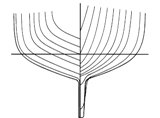

Malua - an Adams cruising yacht


Malua - an Adams cruising yacht
After a hard days slog into the wind we stopped at Gokceada at about 1500 wherepon the wind dropped. We should have kept going and found an anchorage on the Turkish coast but we did not. We left the next day at 5:00 before it was light and motored into a light breeze towards the entrance to the Dardanelles. Give the SE Kumkale point a very wide berth because it is very shallow with a strong current flowing onto it.
The Dardanelles is like a large deep river flowing from the Black
and Marmara seas into the Mediterranean Sea. It has the classic shape
of a meandering stream with the deep sides at the inside of the bends
and the shallows at the outside of the bends. It can get very shallow
in these wide bends so look out. The stream flows down the middle but
there are many counter currents in the bays. Stay just outside the
current line which you can see by the sea grass and rubbish.
The
recommended route north is to take the starboad or Asian side however
if the wind is strong the local yachties seek the shelter of the
European side which requires more vigilance, the pace is slower but the
chop is less. We entered the Dardenelles with a local yacht who took
the port side. We were ahead of him most of the way but as the wind
rose and the chop increased we were under full power but only making 2
knots SOG and he arrived at Canakkale just ahead of us. We did not
follow his advice the next day and struggled into the wind and waves on
the starboard side. The wind was in excess of 20 knots most of the
time.
Well we made the first days run into Canakkale Marina and put the bow
to the wall. The 20mm mooring line was straining under the wind but we
stayed away from the wall. We took a quick walk around the town which
is dominated by the military with off duty conscrips aimlessly stroling
around the town. It reminded me of my weekends in Walvis Bay in the
60's. We visited ANZAC House, a marketing location for Hassle Free
Tours. We signed up for their half day tour of the Gallipoli peninsula.
E60/p
The tour is well organised with a very well spoken (english) and educated turkish guide. We took their ferry across the Dardanelles to a small hotel for lunch and then joined their bus from Istanbul on the tour of the northern battle fields. I met an ex ACTEW employee from Canberra at the hotel.
What can one say about the Gallipoli campaign, the organisation, the decisions, the people and the thousands who died there - one is left speachless. Having heard from people who have walked on the soil, through the trenches and up the hills and gullies I was surprised at how rugged the ravines and terrain actually is. I can understand how the two forces were able to be so close yet move men and supplies right up to the front line. For the British navy to think that they could blast their way up the waterways of the Daedanelles can only indicate that the First Lord of the Admiralty must have had whisky not salt water in his veins. Complete madness. It was a great tour and worth the time and money.
The day was a moving experience, thankfull that I am now too old to carry a weapon ever again.
The next day we set off at dawn before the wind rose and made a few
miles before the full 20knots came right into our face. We were able at
times to raise the staysail and get 20 degrees off the wind which did
help but most of the time it was into the wind and chop. On the bends
the stream gets quite strong and north of Lapseki the shipping lane is
quite close to the shore. We had to take evasive action to get out of
the way of a Turkish ship who wanted to cut the corner at full speed.
On the first day we saw 31 ships and on the second more than 53 - all
at close quarters, not dangerious if everything goes well. I was
pleased to get into the relatively open waters of the Sea of Marmara.
Images of the Gallipoli Peninsula are at ANZAC Cove
The next pages documents our trip in Turkey. We now entered the Sea of Marmara